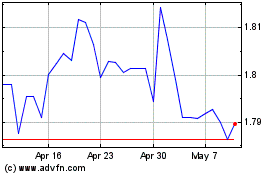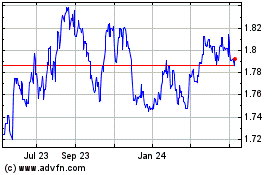UK Construction Growth Weakest In 10 Months
February 04 2019 - 3:24AM
RTTF2
UK construction growth eased further in January to its weakest
level in ten months, amid tepid growth in new orders that lead to
the weakest employment growth in more than two years, amid the
Brexit uncertainty, survey data from IHS Markit showed on
Monday.
The headline construction Purchasing Managers' Index fell to
50.6 from 52.8 in December. Economists had forecast a score of
52.5. A PMI reading above 50 suggests growth in the sector.
The index has posted above the 50.0 no-change mark in each month
since the snow related decline seen in March 2018, but the latest
expansion was the weakest seen over this ten month period of
growth, IHS Markit said.
New order growth was at an eight-month low in January, thanks to
softer demand conditions and longer sales conversion times. The
latter suggested a wait-and-see approach to spending by clients as
they wait for the uncertainty around Brexit to clear.
Slower order growth lead to the slowest expansion of employment
numbers for two-and-a-half years.
Several survey respondents noted that Brexit uncertainty had led
to hesitancy among clients and a corresponding slowdown in progress
on new projects, the survey said.
In January, all three categories of construction output recorded
weaker trends than those reported in December.
Residential work remained the strongest performing area despite
modest expansion in January which was the slowest since March 2018.
Civil engineering growth slowed sharply from December's 19-month
high.
The weakest performing area of construction was commercial work
with latest data suggesting a decline in work for the first time in
ten months.
Anecdotal evidence suggested that Brexit-related anxiety and
associated concerns about the domestic economic outlook continued
to weigh on client demand for commercial construction, IHS Markit
said.
The survey also showed that input buying growth slowed and
vendor performance was the joint-weakest since September 2016.
Input price inflation was the slowest since June 2016, largely
driven by rising prices for imported construction products and
materials.
Despite the recent weakness in growth, construction firms
remained positive about the outlook for business activity this year
with around 41 percent of the survey panel expecting a rise in
output and only 16 percent forecasting a fall. However, confidence
eased slightly from December.
Big civil engineering projects were cited as a key source of
optimism, while Brexit remained the main concern.
Euro vs NZD (FX:EURNZD)
Forex Chart
From Mar 2024 to Apr 2024

Euro vs NZD (FX:EURNZD)
Forex Chart
From Apr 2023 to Apr 2024
